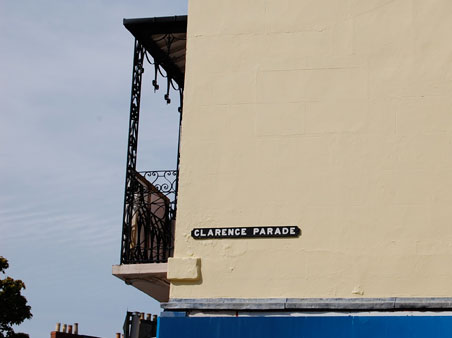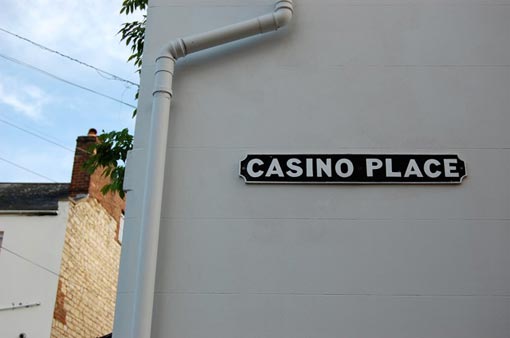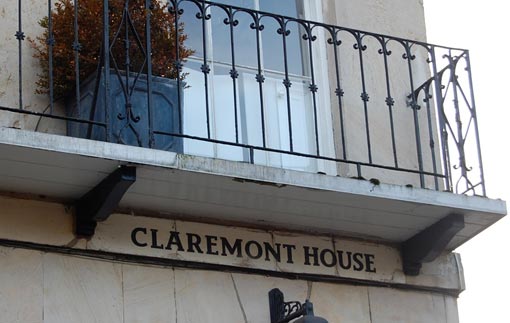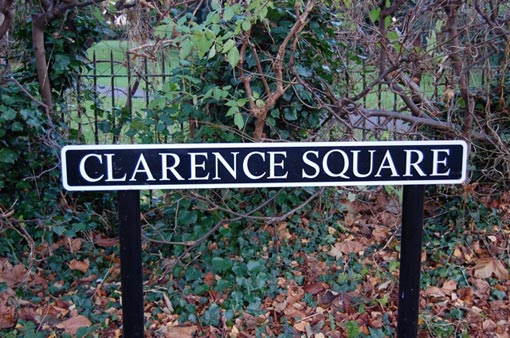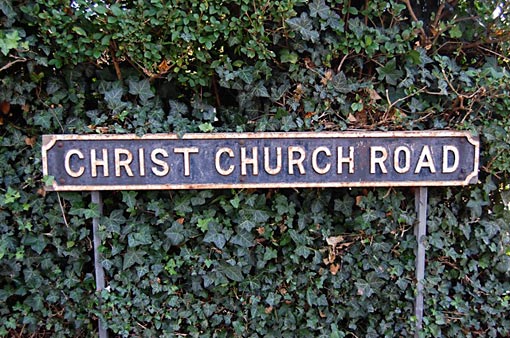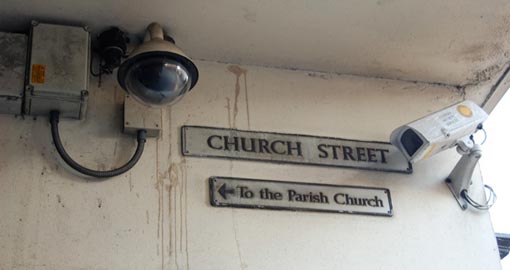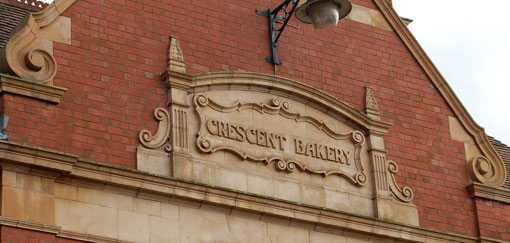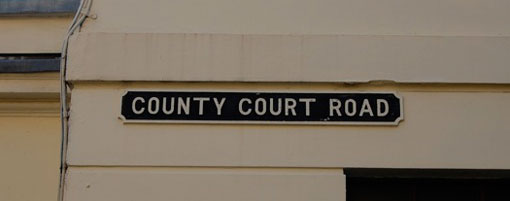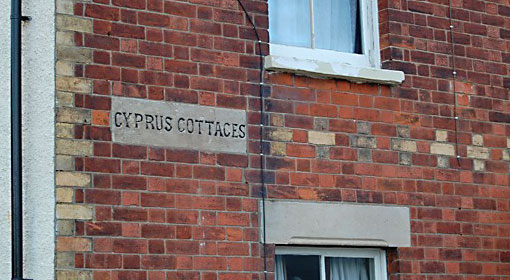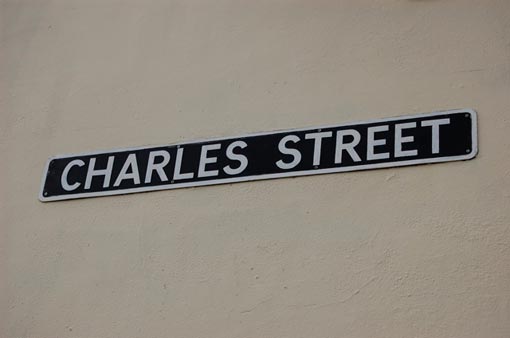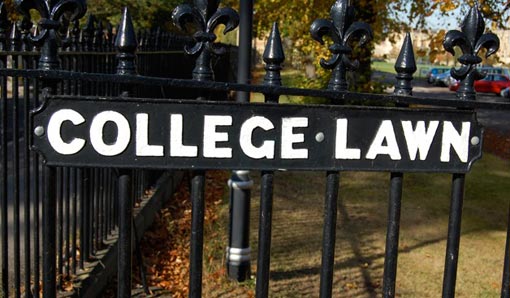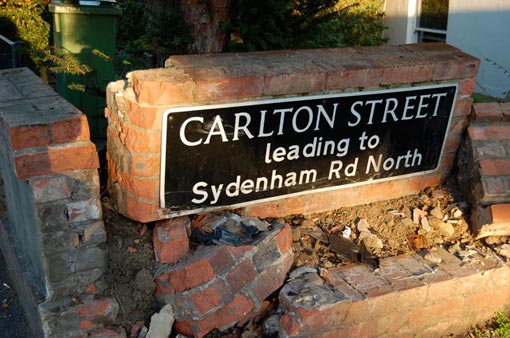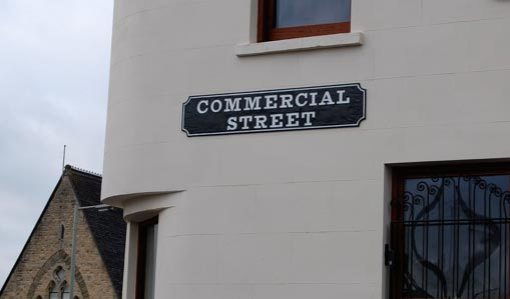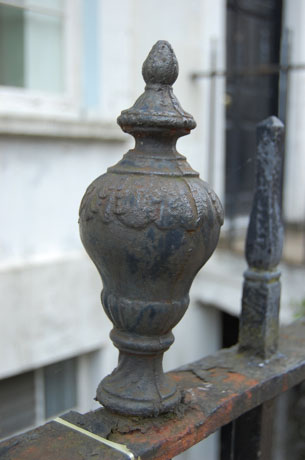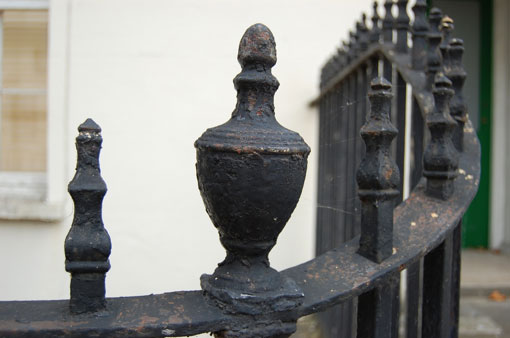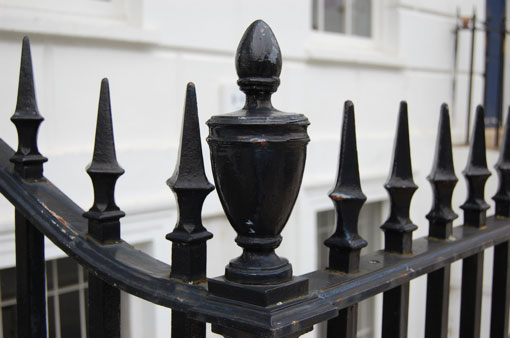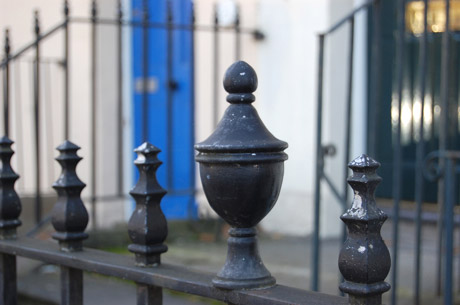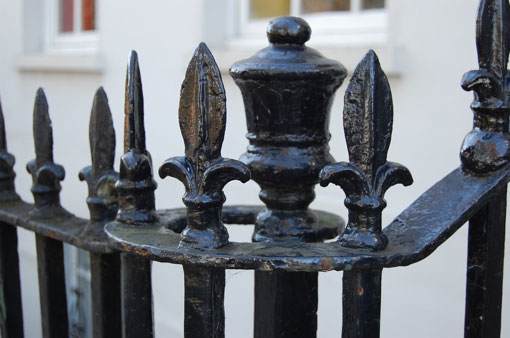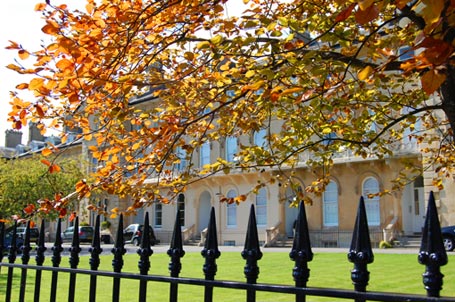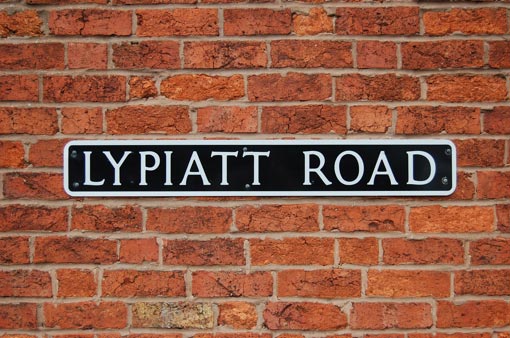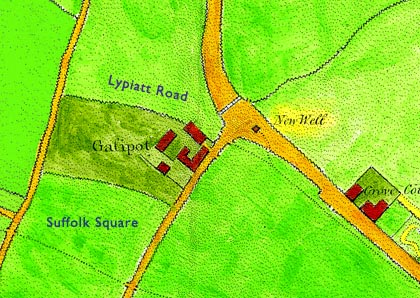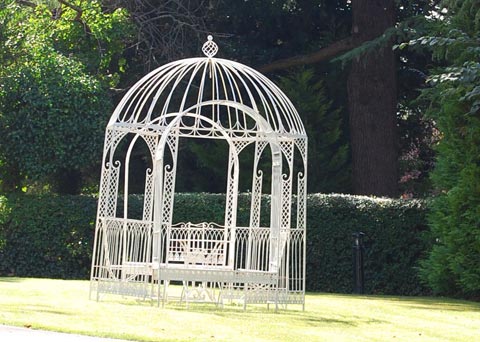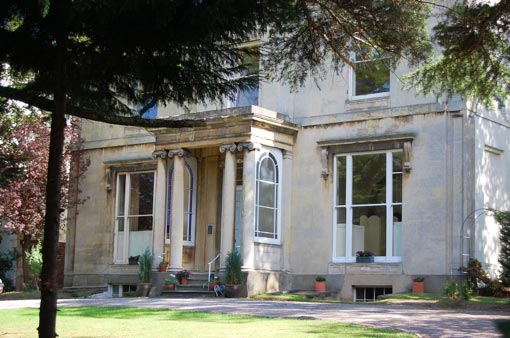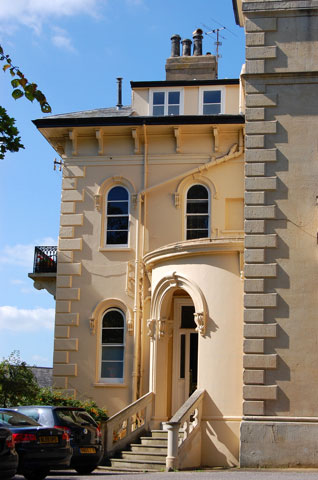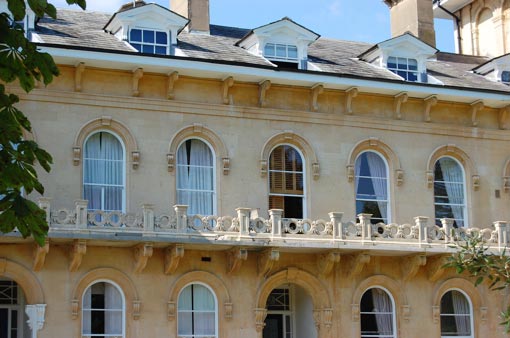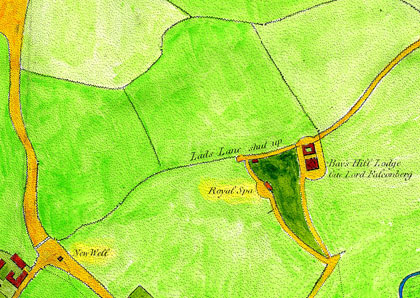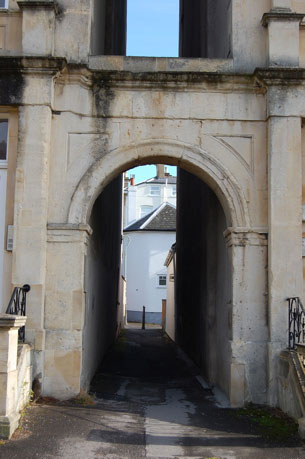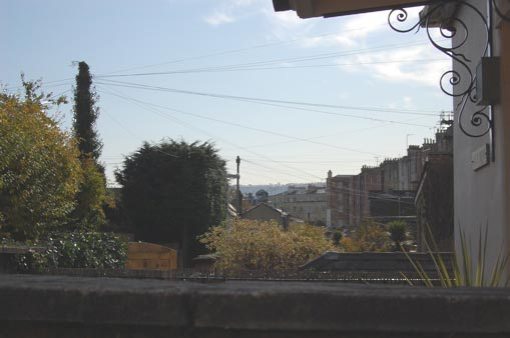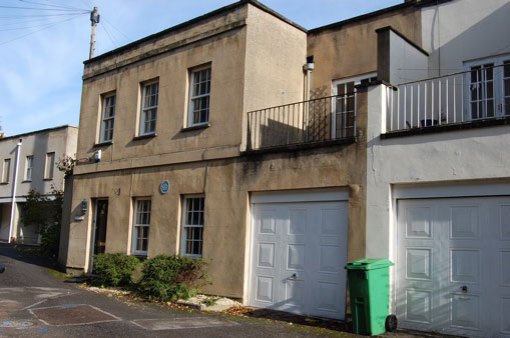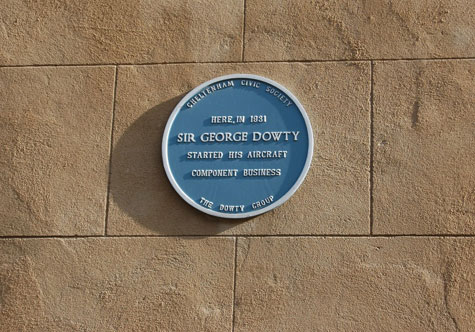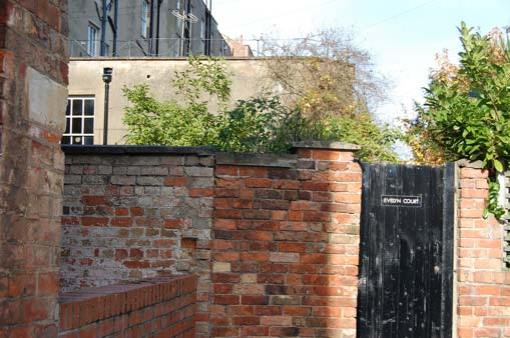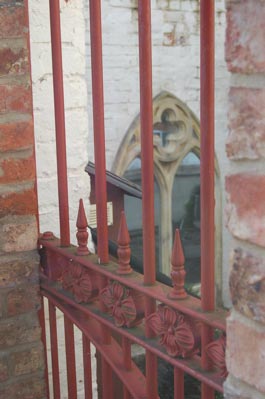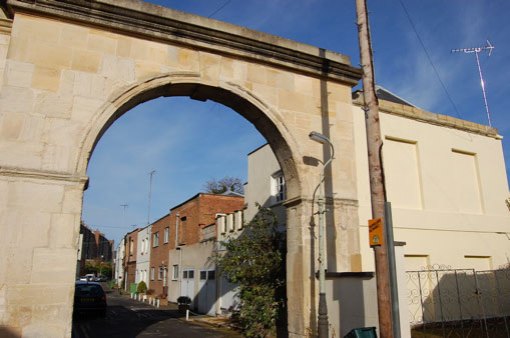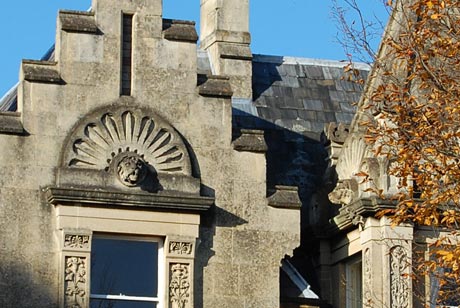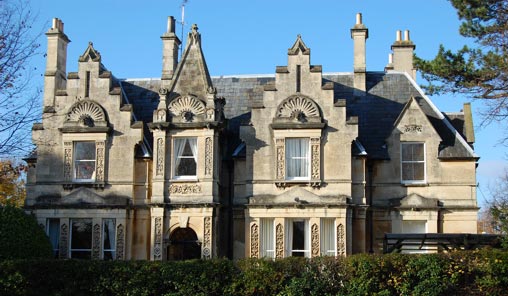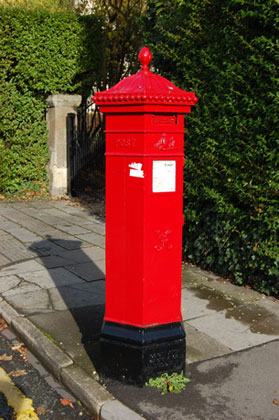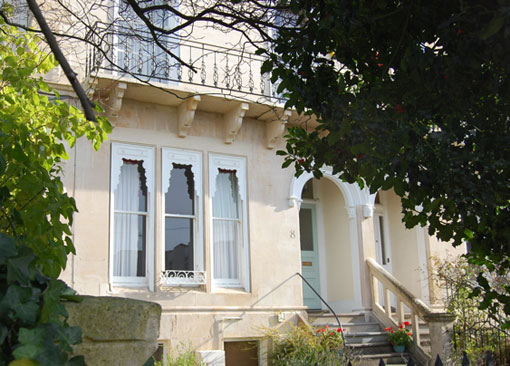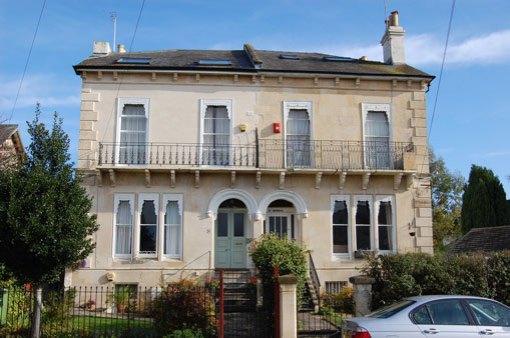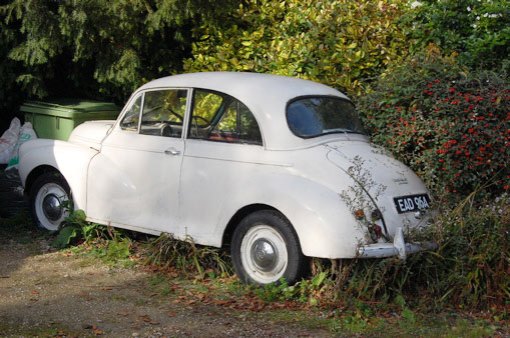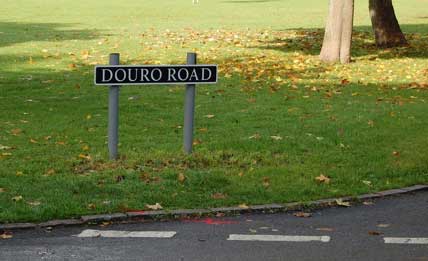
Photos taken November 2008 unless otherwise noted
The name Westal Green chiefly survives these days as the name of a roundabout in the middle of the A40 – barely hanging on to any claim to greenness, its most conspicuous landmarks being a petrol station and a neoclassical electricity substation. But it has a long history – as a medieval tithing, an important six-way road junction, and one-time carpet-beating scourge of Cheltenham.
You could be forgiven for not giving Westal Green a second glance – especially if you’re trying to negotiate its traffic junction. It sits in the middle of the busy Lansdown Road (the main route from Cheltenham to Gloucester) at its junction with Andover Road, Hatherley Road, Lansdown Parade and Queen’s Road. In the past it has been a public open space and to some extent it still is … although there’s not much incentive to dash across the traffic clogged A40 to visit it.
–

Not exactly a shining specimen of Cheltonian beauty, the Texaco garage is what greets the eye when approaching Westal Green from the town side. Note however the elegant mature tree by the right hand entrance to the garage … a relic of a somewhat prettier past. The green was at one time noted for its spectacularly beautiful mature trees … several 19th century writers mention the ancient sycamores, elms and aspens which grew there, “that seem to tell of the ‘forest days’ of a bygone generation, exhibiting a great deal of wild-wood beauty and character in the development of their spreading branches” (Davies, 1843). There used to be a very large and beautiful cluster of trees on the site of the garage, but sadly these are long gone, although parts of Lansdown Road are still pleasantly tree-lined. The block of flats to the left of the picture is Regents Court, built on the site of Nubie House and Elm Lodge.
Believe it or not though, even the petrol station has historic significance. It was built in 1928, and as such was one of the earliest – possibly even the first – petrol stations in Cheltenham. The original building was a curious pagoda-like structure designed by Clough Williams-Ellis, the eccentric architect famous for his creation of the fantasy village Portmeirion on the North Wales coast. Although much altered, extended and re-branded, the garage still retains the original Williams-Ellis roof.
–
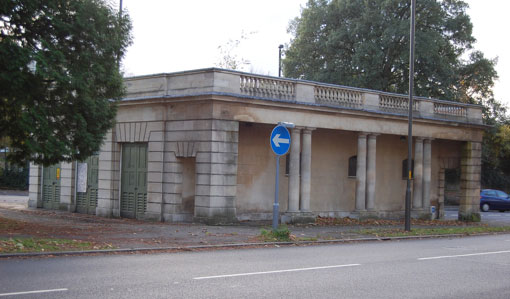
“What’s that?” is the question I’m most frequently asked by guests when passing this strange and rather squat building in the middle of the roundabout. The simple (if not very obvious) answer is that it’s an electricity substation. It was built in 1929, designed in a valiant attempt to blend in with the Regency surroundings of Lansdown and Tivoli. It looks quite pretty on this side with its balustrade and Doric columns, but the rather blind and scary-looking windows, especially round the other side, offset some of its charm. However, as electricity substations go it’s a pretty impressive effort.
Prior to the building of the substation, this spot was occupied by a WW1 tank, of all things. It was presented to the people of Cheltenham in 1919 as a little thank you present for their generosity in investing over two million pounds in war bonds. It sat on its own little concrete plinth in the middle of Westal Green for a mere eight years before being moved to Montpellier Gardens, where it remained – in an increasing state of vandalisation – until it fell victim to the town’s WW2 efforts and was sent to be scrapped and recycled into new munitions in 1940. Steven Blake’s ‘Cheltenham: A Pictorial History’ has a lovely picture of it during its brief Westal Green tenure.
Also on the green around this period was a carved stone drinking fountain donated in 1891 by three elderly maiden sisters, Mary, Anne and Ellen Whish. They lived at 14 Lansdown Parade with their housemaid and cook, and were well known for their charity work for the poor around the Lansdown and Tivoli area. It was topped by a rounded canopy decorated with stone buds, and was given as a gift by these philanthropic ladies to commemorate their 50 years in Cheltenham. When the substation was built in 1929 the fountain was moved to Sandford Park, where it still stands today, just off Keynsham Road.
–

One of the finer landmarks of the Westal Green roundabout is also one of the most overlooked. This pillar box at the side of Lansdown Road is one of eight surviving (and still in use) Penfold pillar boxes in Cheltenham. Arguably the most glamorous public mail receptacle ever to grace the streets of Britain, the Penfold design stands out for its hexagonal shape and decorative beaded cap topped with a cast iron acanthus bud. Queen Victoria’s monogram on the front of the casing gives some idea of the age of the box – they were made for only a few years from 1866 to 1879. Originally it would have had an enamalled flap over the slot, but on this one it has not survived … no doubt these flaps took a lot of punishment over the years from people trying to forcibly cram their mail through the inconveniently petit slot.
The spelling of Westal is variable even today … it is sometimes spelled Westall. It’s a very old name, derived from Westhal, meaning ‘western nook of land’. It first shows up under that name as far back as 1201, when it was a tithing name given to a long stretch of land to the south of Hatherley Road. There is also Westal Brook, a stream which once marked the boundary between Cheltenham and Leckhampton, and which still flows beneath much of Tivoli and Leckhampton today despite a few diversions and a lot of culverting.
One resident of Westal tithing managed to get himself arrested and burnt at the stake in 1556 as a heretic, after travelling to Salisbury and disrupting a church service there. The Cheltenham court rolls record that John Cobberley “who held one messuage and fourteen acres of land [in Westall] was lately attainted and burnt for diverse heresies and false opinions in Salisbury”. (Hart, p.58)
A survey of “Gallipot and Westhall Farm” in 1765 shows the existence of a large farmhouse called Westall on the north side of the green, and presents a detailed record of all the field names in the area. Galipot Farm was an adjacent farm on the site of what is now Suffolk Square. Both farms were then the property of John de la Bere, a well established local landowner.
The junction at Westal Green was probably an important one from earliest times. Although the area wasn’t developed with housing until the 1820s, it was the point where the Naunton and Sandford roads came together and met up with the old road to Hatherley, on what was by then the main route into Gloucester. During the reign of Henry VIII all the inhabitants of Westal were obliged “to help break stones and repair the highway at Westhall and to stone the bridge and make it fit for the King’s lieges to cross without damage to body and goods” (Hart, p.43). Failure to do so resulted in a fine of 5 shillings for all those who owned a plough and 3 shillings for those who didn’t.
From around 1810 Westal Green hosted a rail line for horse-drawn trams, for which purpose the line of present day Queen’s Road was forged across the fields initially as a railroad. Westal Green was the point where the tram line crossed the main Gloucester road. The 1806 map below shows the area just before the railroad was built – when Queen’s Road didn’t exist.
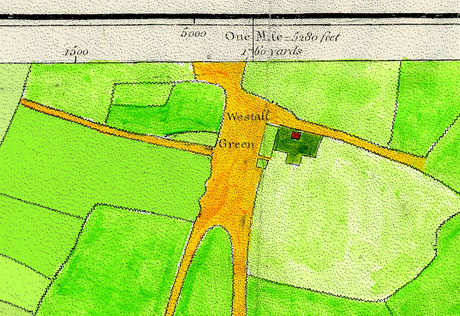
1806 map. The orientation is different from a normal map – south west approximately at the top. It shows one solitary building, probably Westall House. There was no other residential development in the area at all in those days, just open fields, but the junction itself is clearly named. Part of the junction is tantalisingly off the edge of the map, but the wide section at the top is most likely the point at which Hatherley Road branches off.
In 1825 Pearson Thompson began laying out the Lansdown estate, and Westal Green’s status as a rural outpost came to an end. The fields behind Westall House were divided up into building plots for Lansdown Parade, and the line of Lansdown Crescent was carved out, with another terrace of houses – Lansdown Place – taking shape along the main road. Thompson is one of the key figures in the development of Regency Cheltenham but among his contemporaries he was regarded as a bit of a prat. He lived at that time at Hatherley Court, whose large estate then reached all the way up to Lansdown Road and adjoined Westal Green. He took it upon himself to occupy Westal Green as a semi-permanent dumping ground for the stocks of timber, stone, coal and bricks he needed for his building venture – much to the annoyance of everyone else. He even went so far as to instal a private railway siding to make it easier to shunt materials on and off it. Complaints were made about the difficulties of public access across the green and the spoiling of its surface. The Town Commissioners upheld the complaints, and ordered Thompson to dismantle his private railway line within ten days and repair the damage caused.
Thompson’s commandeering of the green wasn’t the only cause of Westal vexations in the Regency period though. In 1831 he sued the other inhabitants of Westal for failing to repair the surface of Hatherley Road, as in those days roads were generally not in public ownership and were the responsibility of adjacent property owners. The residents argued that the upkeep was not their responsibility because the road had never been repaired “within the memory of man” – but this didn’t cut much ice with the judge at Gloucester Assizes and Thompson won his case.
In December 1837 the Cheltenham Looker-On reported a complaint that Westal Green had been “of late years used almost exclusively for the purpose of beating carpets on, to the serious annoyance of the neighbourhood and the frequent alarm of horses”. The issue was resolved by Lord Sherborne, who owned the green at the time and gave permission for it to be enclosed and planted up with evergreens, to become “an ornament for all the surrounding district”.
The large Westall House which had for many years been the focal point of Westal Green did not survive the development of the area. Its last occupant seems to have been the architect Robert Jearrad, who took over the development of the Lansdown estate from Pearson Thompson when Thompson ran into financial difficulties. The 1841 census shows Jearrad living at Westall House with his wife and four children but they seem to have abandoned it to dereliction shortly afterwards because H. Davies, writing in 1843 in his ‘A View of Cheltenham in its Past and Present State’, mentions “a low delapidated building called Westhall, one of the oldest houses in this part of Cheltenham, – and from its present uninhabited state – evidently intended to be removed altogether”. He was obviously right, because its site and grounds are now occupied by a couple of detached villas of circa 1850 (below).
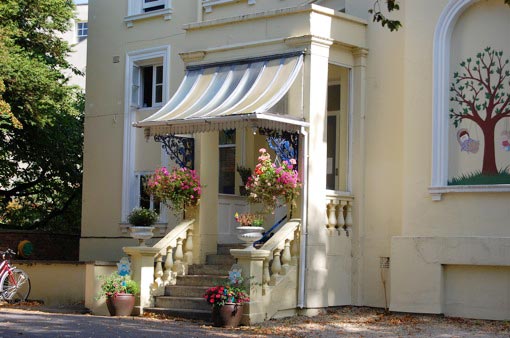
This early Victorian villa, now a children’s day nursery, is one of two built on the site of Westall House and its gardens. It still has a lovely original porch canopy. (Photographed September 2009)
Below are the 1834 and 1921 maps of the area, side by side as they’re interesting to compare.
By 1834 Westal Green takes the form of a triangle of green between the roads, formed by a new short road cutting off the nose of the spur of land – most likely established by force of local habit than by design – with the grand Westall House still standing proudly in its capacious grounds to the north west, in what must up until that time have been quite a rural setting. By now though, development of the Lansdown area was well underway, with Lansdown Crescent and its environs laid out ready for building. Note though, the lighter blue buildings on this map were projected developments only – and much of what is shown here was never built, or was built differently. Only the dark blue buildings were actually in existence when the map was drawn. Tivoli Place in present day Andover Road was newly completed, marked here with its earlier name of Lippiate Street, though the rest of Tivoli was not yet laid out. Lansdown Road is marked here with its earlier name of New Gloucester Road, with the terrace of Lansdown Place half built. Present day Queen’s Road is shown here but without any housing (and with what appears to be a pond beside the junction). The black line running down Queen’s Road and along the south side of Westal Green and down through Lippiate Street is the old horse-drawn tram line which was used in the first half of the 19th century to transport stone and gravel down from the quarries on Leckhampton Hill. Down in the bottom left corner is the line of Hatherley Road – a very old road – with the long driveway down to Hatherley Court branching off it. On the far left is a large chunk of farmland parcelled into plots and named on the map as Westall Garden, with a gardener’s cottage. This area is described as a nursery garden way back in the 1765 farm survey.
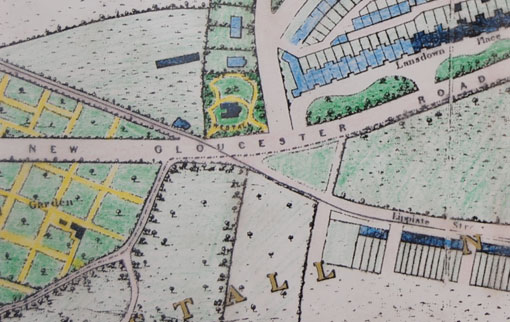
1834 map
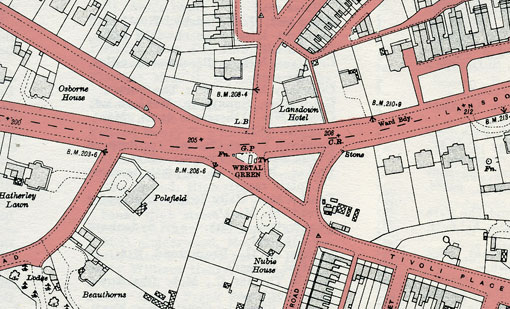
The same area in 1921
There are lots of interesting goodies shown on the 1921 Ordnance Survey map, which is beautifully detailed. The Whish sisters’ drinking fountain is marked at the western end, close to the plinth which housed the WW1 tank. It even shows the location of the Penfold pillar box pictured above – depicted here with the letters ‘L B’ (letter box). With the whole area now built up, Westal Green starts to look like a traffic island rather than a green, and is in two parts. Notice the difference between the proposed development of the Lansdown area on the 1834 map and the actual development shown here. Lansdown Place, originally intended to run all the way to Westal Green and meet up with the corner of Lansdown Crescent, ran out of steam and finished with a truncated end-of-terrace. The vacant plot left over from its non-completion was taken up by a detached villa and the Lansdown Hotel, built in 1843. A narrow footpath runs alongside the hotel to the back of the Crescent. The map also shows that Lansdown Parade was not built in the way originally envisaged – the proposed pairs of semi-detached villas in large gardens shown on the 1834 map were instead built as a terrace of much narrower houses, set back from the road with a carriage driveway and communal garden but having much smaller individual gardens.
There is a ‘stone’ marked on the 1921 map to the north east of the green, though it isn’t clear what type of stone, and it doesn’t appear to be there any more. However in its approximate vicinity I did find this:
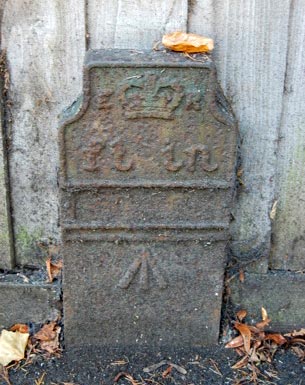
I assume it’s a benchmark for surveying (used in the days before GPS) although it isn’t one of the standard Ordnance Survey types. It has a benchmark symbol (the vertical arrow) and a panel above it which may originally have had an information plate attached to it, presumably giving a measurement in ‘ft’ and ‘in’ as shown. The ER with a crown probably indicates it’s Edwardian.
The 1921 map shows Tivoli expanded into a whole grid of streets, with St Stephen’s Road forging its path over what had been a field boundary in the previous map. A large house – Hatherley Lawn – had been built in what was formerly Westall Garden, although a couple of chunks of the garden continued to flourish for many years until gradually swallowed up by development. It looks as though the original L-shaped gardener’s cottage may have been retained as part of the property, but it’s hard to tell as it isn’t in quite the same place on the two maps.
Also by now Queen’s Road had become a residential street built up with fine villas, its old tram lines long since removed. The magnificent Osborne House now occupied the former nursery garden land between Queen’s Road and Lansdown Road, as it still does today. Westall House, portayed so boldly on the 1834 map, is long gone.

Osborne House, viewed from Westal Green. The wing on the right hand side has been added in more recent times. (Photographed September 2009)
The 1921 map also shows some of the other large houses built around Westal Green during the 19th century. The financial collapse of Pearson Thompson’s property ventures led to the sale of his home at Hatherley Court in 1841, and some of its substantial grounds were sold off separately as high-class building plots.
Nubie House was built some time around 1850. It belonged initially to Mr H. Burgh, an art collector whose death in 1869 gave rise to a lively auction. The house then became home to the Meyricke family whose wealth had come from railway shares, and the five domestic servants listed in the 1881 census gives some idea of the standard of living they enjoyed. Also sharing the frontage onto Westal Green (shown but not named on this map) was Elm Lodge, built around the same time and occupied for its first fifty years by the Reverend Henry Griffiths and his wife Jane. Sadly these fine houses have been replaced by Regents Court. Just round the corner in Hatherley Road is Polefield, bigger than both the other houses put together and occupied in the 1881 census by Robert and Sarah Dick-Cunyngham, who employed eight live-in servants. Robert’s occupation is given as “Baronet Magistrate Land Owner”. It briefly became a hotel in the 1920s. Next door and very slightly more modest was a house originally called Syndale House, which was renamed Beauthornes by its new owner when it was sold in 1858. All these fine houses were built on land which was originally part of the Hatherley Court grounds until Pearson Thompson was forced to sell up.
The Lansdown Hotel and Boarding House on the north side of the green was opened in 1843, initially let to a Mr Morrison, “the well known conductor of Mount Pleasant Hotel, Malvern, who has relinquished his interest in that establishment”. George Rowe gives it a mention (and a picture) in his ‘Illustrated Cheltenham Guide’ of 1850: “its suburban situation, in the immediate fashionable neighbourhood, together with its contiguity to the Railway Station, are additional inducements to make it become a general favourite.” A generation later the 1881 census shows it as an all-female establishment, run by Mary Darby and her three unmarried daughters. Apart from the boot boy employed at the inn, the resident staff were all women.
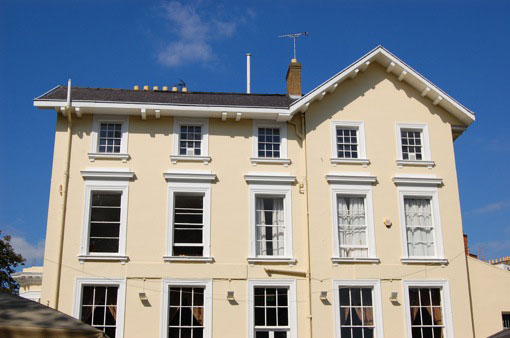

Two views of the former Lansdown Hotel on Westal Green. The lower picture is the back of the building, viewed from Lansdown Parade. It is still a pub and hotel today.
–
Brian Torode’s ‘The Story of Tivoli’ was particularly useful in the making of this article.
